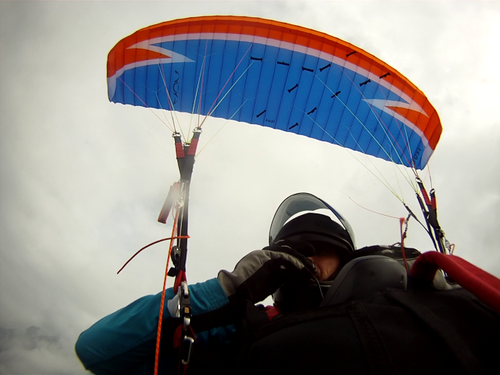SuSi M |
|||||||||||||||||||||||||||||||||||||||||||||||||||||||||||||||||||||||||||||||||||||||||||||||||||||||||||||||||||


|
|||||||||||||||||||||||||||||||||||||||||||||||||||||||||||||||||||||||||||||||||||||||||||||||||||||||||||||||||||
Instability rating |
|||||||||||||||||||||||||||||||||||||||||||||||||||||||||||||||||||||||||||||||||||||||||||||||||||||||||||||||||||
|
|||||||||||||||||||||||||||||||||||||||||||||||||||||||||||||||||||||||||||||||||||||||||||||||||||||||||||||||||||
Glider characteristics |
|||||||||||||||||||||||||||||||||||||||||||||||||||||||||||||||||||||||||||||||||||||||||||||||||||||||||||||||||||
|
Launch preparations: easy
launch characteristics: balanced, climbs constantly, no guidance necessary, good feedback during inflation, little braking required, slows before zenith, control check simple, low takeoff speed
asymmetric collapse: canopy colllapses at high angle to leading edge, en: EinklapperDynamikGering, total course change 90-180°, (1), moderate course change rate, low forward pitching <45°, (1), low height loss 20-29m, (1), low sink velocity 10-14 m/s, (1), G-Force < 2,5 G, (1)
Frontal collapse: canopy collapses with high total collapse aera, moderate pitch backwards 30-45°, marked pitch forwards 45-60°, moderate dynamics, no course change, (1), immediate automatic recovery, symmetric recovery, immediate return to normal airspeed, low height loss 20-29m, (1), very low sink velocity <10 m/s, (1)
Spiral dives: moderate sink velocity increase, Very low G-Force < 3 G, (1), Sink velocity after 720° <14 m/s, (1), Moderate maximum sink velocity < 18 m/s, (2), sink velocity increase < 6 m/s on brake release, (2), Course change 360-540° after spiral exit, (3), high height loss during recovery 60-100 m, (3)
B-Stall: high force required, moderate pitch backwards 15-30°, marked pitch forwards 30-45°, stable sink phase, no tendency to deform, immediate return to normal airspeed, 8-10 m/s, height loss on recovery < 20 m
big ears: simple initiation, stable flight phase, immediate automatic recovery, Vsink unaccelerated 2,5-3 m/s, Vsink accelerated 3-3,5 m/s, Vunaccelerated 3-5 km/h less than trimspeed, Vaccelerated 3-5 km/h faster than trimspeed
Steering behaviour: dampened, 80 cm brake travel range, very noticable brake pressure increasse, Late stall point, easily identifiable |
|||||||||||||||||||||||||||||||||||||||||||||||||||||||||||||||||||||||||||||||||||||||||||||||||||||||||||||||||||
Notes |
|||||||||||||||||||||||||||||||||||||||||||||||||||||||||||||||||||||||||||||||||||||||||||||||||||||||||||||||||||
|
Launch Characteristic: our of the five LTF-A gliders demonstrated good school suitability in terms of launching the glider. For this segment it is particularly important that gliders do not tend to overshoot, as this quickly over-c hallenges new pilots. Niviuk Koyot 2, Icaro Cyber TE, Nova Susi and Ozone Mojo 4 are all excellent here. Their canopies climb steadily with comfortable pressure on the A-risers and slow automatically as the reach the zenith. Only moderate brake appliance is necessary to stabilise them. Asymmetric Collapse: Novas SuSi M was the least challenging glider tested here: the glider is designed with simplicity and ease of handling in mind with large air intakes and a low aspect ratio and reacts very benignly to asymmetric collapses. Front Collapse: Novas SuSi rarely needs more than 25 m to recover from even the hardest „destroyer“ front collapse. The canopy opens very quickly and regains normal speed without delay but with a tendency to dive somewhat. Spiral Dive: Recovery relatively challenging as the glider continues to spiral and automatic exiting is delayed. Relatively low G-forces. B-Stall: The LTF-A glider Nova SuSi, displayed good behaviour in B-stalls. No deformation tendencies, stable sink phase with good sink rates and no recovery or deep stall problems on exiting. Big Ears: Performing big ears on all of the tested gliders was unproblematic. |
|||||||||||||||||||||||||||||||||||||||||||||||||||||||||||||||||||||||||||||||||||||||||||||||||||||||||||||||||||
Rating |
|||||||||||||||||||||||||||||||||||||||||||||||||||||||||||||||||||||||||||||||||||||||||||||||||||||||||||||||||||
|
Safety class 3 This class of paraglider react moderately to one or more of the following manoeuvres: frontal collapse, asymmetric collapse or spiral dive.Moderately means that the above manoeuvres result in dynamic reactions from the glider and/or large height losses. Good piloting skills which need to be regularly practised, together with good personal reaction times which are above basic training levels are required to safely fly this class of gliders. Skill and experience levels greater than those attained in basic training are required to safely recover from the above manoeuvres. Emergency descent manoeuvres, in particular spiral dives may require advanced recovery skills. Additional training such as regular ground handling or SIV training is recommended. |
|||||||||||||||||||||||||||||||||||||||||||||||||||||||||||||||||||||||||||||||||||||||||||||||||||||||||||||||||||

